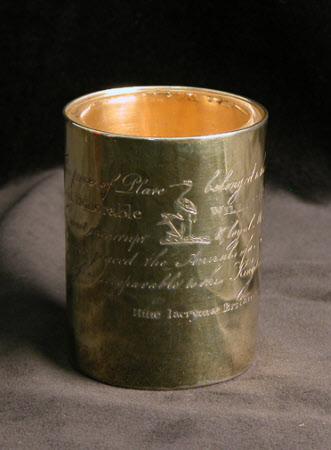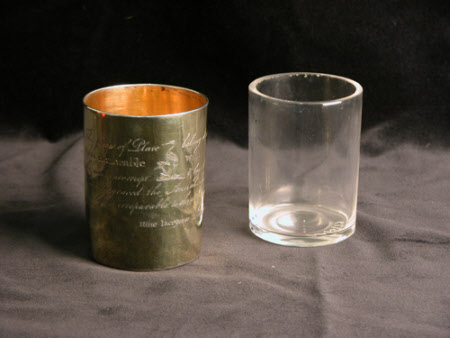Beaker
John Emes
Date
1800 - 1801
Materials
Silver, silver-gilt
Measurements
9 x 7 cm; Weight 140 g
Place of origin
London
Order this imageCollection
Anglesey Abbey, Cambridgeshire
NT 516470
Summary
A beaker, silver-gilt (sterling), mark of John Emes, London, 1800/1. Raised from a sheet of silver, the beaker’s cylindrical sides sit on a flat base. Engraved with the crest of William Pitt, and inscribed: 'This piece of plate belonged to the late Right Honourable William Pitt, the most incorrupt and loyal minister that ever graced the Annals of a Nation, his loss is irreparable to this kingdom. Hinc lacrymac Britannorum'. With a cylindrical glass liner. Hallmarks: On the rim: ‘JE’ (for John Emes*), lion passant (sterling), leopard’s head (London), ‘E’ (date letter for 1800/1), and monarch’s head (duty mark) *Arthur Grimwade: London Goldsmiths 1697-1837, 1990, p 134, no 1807 Scratch weight: None
Full description
HERALDRY The crest is for PITT, Earls of Chatham and their descendants. William Pitt ‘the Elder’ (1708-78), an eminent politician and Prime Minister 1766-68, was created Earl of Chatham, Viscount Pitt of Burton Pynsent, in 1766. The crest is for his second son, William Pitt ‘the Younger’ (1759-1806), who did not inherit the earldom; the lack of a coronet over the crest accords with this. The younger William Pitt was an outstanding statesman of his era. He first entered Parliament in 1781 for Appleby, a pocket borough seat under the patronage of Sir James Lowther, later 1st Earl of Lonsdale, where the previous member had been Lowther’s distant cousin William Lowther, later Viscount Lonsdale and 1st Earl of Lonsdale of the second creation (q.v. NT516449 and NT516459). After being re-elected for Appleby twice, on appointment to office in 1784 Pitt was elected for Cambridge University, which he represented for the rest of his parliamentary career. He is best remembered as the youngest Prime Minister, aged 24 when he took office. He served as the last Prime Minister of Great Britain from 1783, continuing as first Prime Minister of the United Kingdom after the Act of Union in 1800 until his resignation in March 1801; then again in 1804 until his death in 1806. His inclinations were in some ways reformist but the tumultuous events of the period and their consequences dominated his ministries. His integrity was proverbial: in a venial age and as a consequence of refusing sinecures he was always financially insecure. He died at the young age of 46 exhausted and ill, reportedly exclaiming on his deathbed ‘Oh my country! How I leave my country!’. Jane Ewart, 2025
Provenance
(Urban) Huttleston Rogers Broughton, 1st Lord Fairhaven (1896-1966); bequeathed by Lord Fairhaven to the National Trust along with the house and the rest of the contents. National Trust.
Credit line
Anglesey Abbey, the Fairhaven Collection (National Trust)
Makers and roles
John Emes, goldsmith

